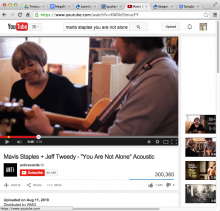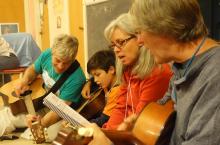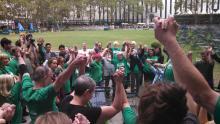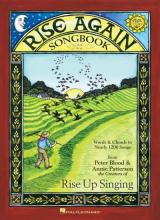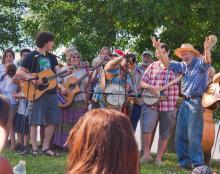How to Lead Groups in Song
In 10 Easy Lessons
(For more detail on this subject, we strongly recommend you buy a copy of Ben Kramarz' terrific book A Guide to Songleading and Communal Singing.)
We have been both been leading sings for many, many years in hundreds of different settings from folk festivals, camps, schools, churches, and picket lines to living rooms and conferences of over a thousand people. Having people sing together can be uplifting, joyful, powerful and exhilarating. It can also be a terrific dud! It is not just chance. Here are some of the things we’ve learned that make a difference.
#1 The Song Leader(s). Leaders need to have a strong, confident style of singing. They need to be able to project their voice “over” the crowd. Otherwise people may not be able to hear the tune, stay on pitch, stay on the beat. A strong confident voice is infectious. Pete Seeger in his prime was the virtuoso of this! (Here is a video of him leading singing at a huge concert a couple of months before his death.) However, if you have the energy to start a singalong but don't feel you are a confident singer please don't feel discouraged! We suggest you connect with a couple other musician friends and plan to share leadership responsibilites. It takes a village to start a sing. Sometimes great songleaders don't have the organizing skills that it takes to get the word out!
It obviously helps if songleaders are good singers themselves. Sometimes a songleader may be off key or maybe doesn't know a song as well as they thought. That's okay! Be upfront in a compassionate way. Help each other out. Everyone makes mistakes and it's okay to suggest the group try that song next time. If there are strong singers in the group, this can help to make up for some weakness in the songleader’s singing gifts. Always have at least 3 or 4 upbeat songs that everyone knows ready to go if you stumble or if the group just can't get through a song without going off the rails. Most folks are willing to sing old chestnuts if it means getting the group back on track (This Little Light of Mine, City of New Orleans, I'll Fly Away, Deep River Blues, My Blue Heaven, etc)
Not Overpowering the Participants. Sometimes songleaders can unintentially dominate a sing which can make it hard for the group to hear themselves. Good songleaders will often experiment with stopping singing at times once a song is going really well so the group can “hear itself”. Doing an acapella verse can also have the same effect. It can be fun to sit out and listen to the group!
Shared Leadership. Many song circles go around the circle and let different people take turns leading or singing a song. This communicates the message that music belongs to everyone and that everyone has an opportunity to lead. As in many other spheres, however, “democracy” occasionally competes with quality. If some participants don’t want to lead a song, you can still move around the circle allowing each person in turn to choose a song. You can leave the option for the person who’s turn it is to either lead the song or request a song and let someone who knows it and feels confident doing so lead it. We personally thing having one or two hits ready to sing as a group before going around the circle can help set the tone for an evening.
If you have a large sing or one where people have paid money to attend like the singalong concerts we often lead, you may want to address whether or not you will allow members of the group to bring their own instruments and play along. In some settings we’ve had people do this and it’s worked out great, but more often these days, if it's a concert setting with an admission fee, we usually arrange for folks to join us by prior invitation.
#2 An “Alive” Space. Acoustics make a huge difference. A lively room helps people hear each others’ voices, helps the group to stay together and just makes everyone feel good about how they sound. It also makes it easier for participants to hear the song leader. Look for rooms that don't have wall to wall carpeting. Some libraries have difficult acoustics because they are carpeted.
#3 Seating Arrangement. If people face each other in a circle or semi circle they can usually hear each other better. The closer that people are to each other and to the leader(s) the better. We find that concentric semi-circles around the leader(s) make for a more successful sing. If you have people sitting in rows in a long room, those in the back are a long way from the leader. The leader cannot easily hear them singing and they cannot hear the group easily. Wherever possible we re-arrange chairs or benches to have everyone sitting within 4-5 rows of the leader and arranged more or less around the leader. If you are doing a singalong without a designated leader or 2, then a circle or several concentric circles might work the best.
If your room has to have people in fixed rows facing one way (as in a church or synogogue with pews), try and get people to sit as close as possible to the front. I (Peter) have lowered myself to making jokes about how people who sit close up will live longer. You can also put up ropes or ribbons beyond the front rows in a room that’s a lot larger than your group.
If you are not sure how many people are going to attend a singalong, start out with a smaller number of chairs so people will not follow their natural tendencies to sit in the back. You can leave chairs stacked at the back that can be set up if more people arrive than you set up for initially.
Along the same line, it’s generally better to choose a room that’s too small than one that’s too big. If you have a room that’s a bit too small, it will be full, energy will be high, and people feel like they are at something that is popular and successful. If you are in a room that is too large, it’s hard to hear each other, people feel more disconnected and the sense is that “not enough people chose to come” – or “why were you the only ones that showed up?”
#4 Amplification. Amplifying a song leader’s voice and instrument will probably sound like blasphemy to many singalong traditionalists! If you are trying to sing together in a group that is larger than 40 or so people, amplification can be a great contributor to success.
For people to sing together they need to be led. Otherwise it is easy to become off rhythm or off key with each other. The larger the group, the poorer the acoustics, the less experienced the singers and the less familiar participants are with the songs being sung, the more important this is. The audience at soccer matches in Wales may be able to join in rousing four part harmony hymns without a formal leader but these people know the songs and are really good singers.
If you are trying to lead singing in a large group, seriously consider asking for amplification. You will be able to hear your own voice much better and the group you’re leading will be able to hear you.
#5 Communicating the Beat. For people to sing together they need to stay united in their rhythm. Again, the less experienced the singers are, the more critical this is. You can communicate the beat to participants through your voice, but the instrument(s) played by the leader(s) are also critical. Strong steady beats on the guitar are the classic way of doing this, but you can also use a piano, autoharp, or drum.
If it’s an option you may want to find a upright bass or piano player who can play with you and provide a strong easy to follow beat to the group.
Conducting is also an option. It probably feel way to weird for a song circle in a living room, although we do it informally sometimes when we do rounds. It is particularly challenging for a group to stay together during comlex rounds, so one person in the middle moving their arm up and down can help a lot.
#6 A Capella. Singing a capella can have a special magic that never occurs with instruments. You can hear the pure mingling of voices and the harmonies when singing a capella much better. Rounds are a great way to sing a capella. So are rousing songs like African American Spirituals and sea shanteys.
Another great way to sing a capella is to have the instruments drop out midway through a song or on the final verse. If you are singing with a bunch of people playing instruments, others may not realize that you would like to have them stop playing (or even that you have stopped playing!) Try calling out: “Let’s try singing a capella now!” between verses.
#7 Lyrics. Everyone in sone audiences know songs well enough to sing them without any other help. This is often true at campfires and for families and other groups that have been used to singing together for a long time.
Many song leaders like Pete Seeger traditionally have encouraged people to join in on choruses or on the whole song if they knew it, but don’t expect people to sing the whole song together.
Having a hymnal, songbook or wordbook like Rise Up Singing makes it easier for everyone present to sing the whole song together. Many people can pick up a new tune quickly and join in the whole song if they have lyrics in their hands, particularly if they are being led by a strong songleader.
Pete has experimented with making large banners with lyrics or even the music for a round to spread out on a stage. We have often experimented with using overhead projectors. If you use a program like powerpoint to project lyrics it greatly restricts your spontaneity in the selection and order of songs.
At Sing Out’s 60th anniversary singalong concert held in Philadelphia in October 2010, an online version of Rise Up Singing was used to project lyrics on a large screen. Even this was fairly awkward and only worked as well as it did because of the fact that the songleaders selected songs in advance. At some point in the future we would expect Rise Up Singing to be available in some kind of easily searchable online format that would enable easy projection of all the lyrics in the book onto a screen, but we aren’t there yet.
#8 Song Selection Part A – Singability. Many terrific songs are just not easy to sing in groups. Especially without practicing like in a choir. (Even a book like Rise Up Singing contains songs that work much better than others in this respect.) You want to definitely start out with songs that just lend themselves to group work near the beginning & have plenty in the mix.
Song circles and small informal singalongs usually allow everyone present to take turns choosing songs. We someetimes do this at concerts but it is risky. It is important not to try and lead songs that you don’t really know or it can really bomb! Sometimes you start leading a song and only realize part way in that you don’t really know it well enough. So be realistic and don’t try leading songs you really don’t know!
We find it best to start a concert with at least a half dozen songs that we are confident will work well. This really helps to “prime the pump.” After the group is singing together well and has a good sense of its own musical energy, it may be fine to throw it open for requests “from the floor” if you know lots of different songs. It’s good to have a list of songs that you know really help the group to gel that you can go to when there is a song or 2 that don’t work as well for whatever reason.
We often give young people preference in making requests, especially early in the concert. (But don’t expect children to only request “kid’s songs1”)
In a large concert not everyone will be able to get even one request in an open request format. We often leave a request list at break & then choose songs that we know well & know will work well for group-singing in our second set.
#9 Song Selection Part B – Content. In many settings you may be looking for songs on a particular subject. Rise Up Singing & Rise Again make it easy to find songs on a particular subject. Many chapters are based on subject matter (e.g. on earthcare, economic justice, peace or freedom songs). These chapters also have lists at the end of the chapter of other songs on the same subject elsewhere in the book. It will be possible soon to do searches on this website (uner ”Songs”) for songs on a specific subject.
We choose use a high portion of songs that have a strong progressive content and help to empower people. You may want to think ahead of time of what kinds of songs you want to cover at a given sing and then hunt for a list reflecting this before the concert or other singing event.
It often helps to keep up the energy at a sing to have a mix of contents. Don’t do too many songs that are sad in a row, for instance. On the other hand, you may not want to have a very silly humorous song right after an extremely serious song.
#10 Learning from Others. A great way to pick up these ideas is to watch others do it. Find a singalong in your area: here's a list. You can also do a search for a folk song or folk music society in your area. Most of these run song circles and singalongs.
We lead singalong concerts frequently across the country. See www.riseupandsing.org/events. There are many professional musicians who make group singing a central part of their concerts. Here is a list of some of our favorites song-leading musicians: www.riseupandsing.org/singing/concerts/other-musicians
And finally: have fun! Ultimately, for us, singing is about building community, uplifting hearts and pleasure. We hope you enjoy over time leading groups in song as much as we have!
p.s. Here are some more ideas for your songleading:
- Elevating Group Singing with Props & Visuals by Jennifer Dean






